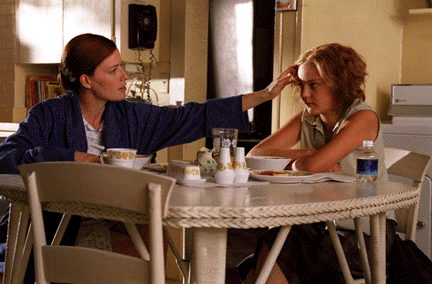When You Say Nothing At All ... Open Spaces on the Page and the Canvas
'You say it best when you say nothing at all' ... don't worry, this isn't a 90s nostalgia blog dedicated to Notting Hill! Rather, I've been thinking about a theme that affects both the written word and the painted canvas. Whether in art or in fiction, is what we leave blank as important as what we create?

I was inspired to consider this topic after reaching the end of Elizabeth Strout's 1998 debut novel Amy and Isabelle. Without too many spoilers (and it is in the blurb on the back cover!) Isabelle and Amy are mother and daughter, and the novel explores their long road back to understanding after Amy begins an intense affair with her maths teacher. For Isabelle, driven by her own past pain to present a serene, socially acceptable face to the world, this is a devastating turn of events. I was intrigued to see how a skilled writer like Strout would handle the 'big reveal'. It is Isabelle's boss, Avery Clark (a man Isabelle also secretly harbours romantic feelings for) who first discovers Amy and her teacher together. The chapter in which he returns to their factory office in order to tell Isabelle ends like this:
'Isabelle, sitting at her desk tired and hungry this time of day, had just straightened up her paper clips and let out a deep sigh, when glancing over at the clock she saw Avery Clark stride into the room and thought: Someone important has died.'
I want to highlight just how powerful Strout's writing is because of her restraint. Snippets of Avery's conversation with Isabelle (and Isabelle's conversation with Amy) do appear as the novel progresses, but at this key moment I was moved by how the novel sticks to an understated, naturalistic style (and avoids descent into soap opera melodrama!). A detail like 'straightening up her paper clips' seems tiny - everyday and unremarkable - yet when the reader knows what we know, it also functions as a symbol for Isabelle's tragically flawed belief that she can control the world around her. Take a moment to imagine how people really behave when 'someone important has died'. Eyes down and sombre, somehow out of their depth? We (and Isabelle) don't have the facts yet, but we certainly have the feel. And for Isabelle, of course, something has died: the innocence she so wants Amy to retain and her own hopes for an outwardly perfect existence.

This dignified, restrained use of space can work in art too. Technically, it's referred to as negative space. When painting one of my signature cherry blossoms, for instance, the 'blank' white areas around the tree may be unmarked, but they still play an important role in helping me to reinforce the sense that the artwork is a delicate study of one moment, rather than a full-on traditional landscape.


Negative space can also help us to achieve a more precise representation of trickier subjects. If you're struggling with an animal's paws, try focusing on the spaces between them! This strategy works similarly for my feather ink illustrations, in which I want to create an effect of graduating scale as the feathers tumble from the sky. Sometimes an absence can be active, if you see what I mean!
Whether in painting, poetry or prose, we can even make the most of our mind's 'blank spaces'! If you take ten minutes to reflect on your novel's characters, or on your painting's subject, then that time is not wasted. It might never be put into words, or painted onto the canvas, but that moment of stillness will support you in having the confidence and clarity to make more thoughtful, deliberate marks. By cultivating the skill of space, whatever we do choose to create becomes a bit more meaningful.

Line of the Month (my favourite line I've written this month - although whether it makes the final cut is a different story!) We might call this piece 'ode to an ice cream ...':
'Outside in the still-brisk March weather, today’s cone is so cold that real flakes of ice lie dusted over it. Ellen prods one with her tongue: close up it looks crisp and almost blueish, like a dolls' house snowflake.'
Iced-over ice cream will be familiar to many Scots ('we're going to have a day out, dammit, no matter how cold the weather!) Mmm, who knew writing could be such hungry work?!

In the Frame (a fancy way of saying: 'here is my painting of the month'!)
Tracey Emin, You Loved Me Like a Distant Star, 2012. Neon, 147.3 x 165.1cm. Lithograph print created and signed 2016. 70 x 50cm.
Ok, so we've jumped roughly 500 years ahead in art history since last month's choice, but there's nothing wrong with having eclectic tastes! This piece has been in my head since Mother's Day, because my Mum very - very! - kindly gave me a signed edition for my last birthday. Subtle yet contemporary, I love how this work juxtaposes neon (typically a material we'd find in industrial, larger-than-life urban settings) with handwritten, heartfelt sentiments. Space is important in this work too: we see, if not quite an open heart, then certainly an honest one. And how does one love 'like a distant star'? Perhaps it means simply watching over our loved one: a guardian angel who doesn't hover but shines bright when you need her most? Love you Mum!

















